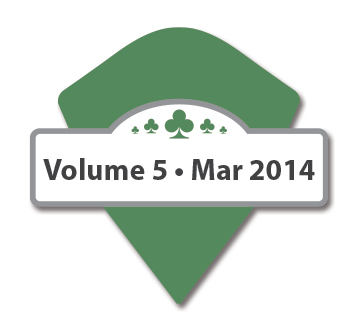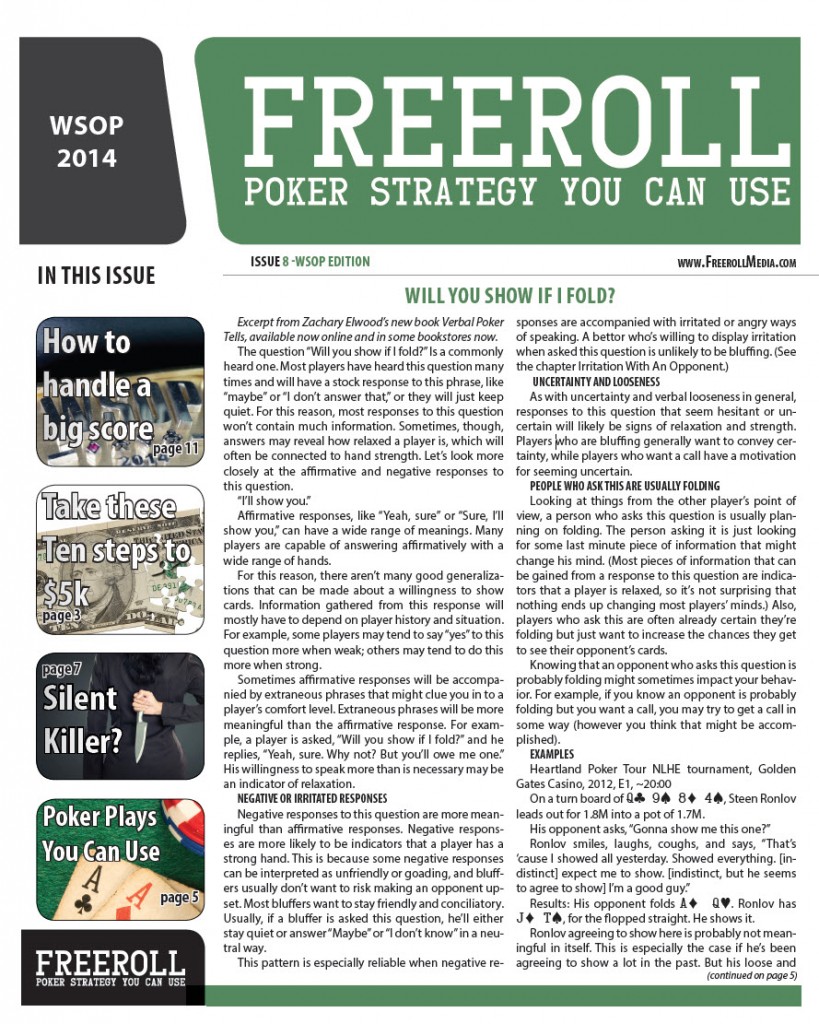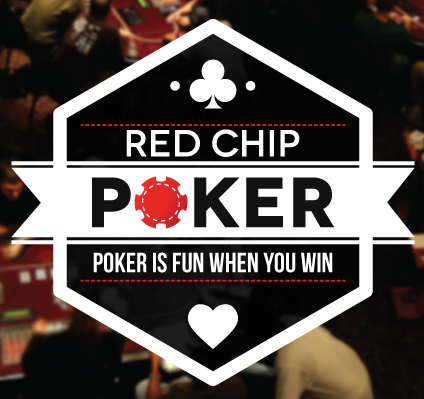Poker Is A Skill: How to Stop Losing, Part 4
- By Paul Hoppe
- March 20, 2014
- Comments Off on Poker Is A Skill: How to Stop Losing, Part 4
Expected value is one of the most important concepts in poker, in all types of gambling, and in life. It represents the mean outcome of any decision.
When you flip a fair coin, it will come up heads half the time and tails half the time. If we make a bet where I owe you $1 when it lands heads and you owe me $1 when it lands tails, that would be a fair bet. The expected value for each of us would be $0. Neither of us profits from making this bet, but maybe we have a little fun.
If instead of betting $1 straight up, I laid you odds of 2-to-1, meaning that I give you $2 when you win and you give me $1 when I win, then you would have a positive expectation and I would have a negative expectation. For every 2 times we toss the coin, I would expect to lose $2 and win $1. That’s a net loss of $1 over 2 flips. One dollar divided by two equals fifty cents. So the expected value of a single flip of the coin would be negative $.50 for me, and positive $.50 for you. That’s a good bet if you can get it.
What if the coin were not fair? What if I had Harvey Dent’s coin (before he lost half his face)? It wouldn’t matter what odds I offered you. I’d always win the bet. In the case of our $2-to-$1 bet, my expectation would be positive $1 per flip, since I would always win and never lose.
Let’s do one more complicated flip. I read somewhere that a quarter does not come up 50% heads and 50% tails. It’s more like 70% tails and 30% heads. I read this on the internet, so it’s probably a load of crap. But humor me. Let’s say I find a coin which is weighted in such a way that it lands tails 70% of the time. Now when I offer you $2-to-$1, I’m actually making money. We’ll do the math:
30% of the time I lose $2, so that’s -$.60. 70% of the time I win $1, so that’s +$.70. We simply add those two numbers together and get $.10. I come out ahead a dime every time we flip the quarter. My expected value on this coin flip is ten cents.

Poker works much the same way as these coin flips. Your odds of winning are changing from hand to hand and street to street. The odds you get from the pot change with every bet and call. What you need to do is calculate the odds and figure out what sort of coin you’re flipping.
Maybe this sounds complicated. It is. But it’s not. The basic math of poker is arithmetic, not calculus. As you improve, you can work on more complicated equity calculations, but for this article we’ll keep things simple. We’ll look at drawing to a straight.
Let’s say you’re playing No Limit Holdem and you hold JcTc. The flop comes out 9h8d2s. You have what we call an open-ended straight draw. Any queen or seven will give you the best hand. Let’s further stipulate that your opponent holds pocket aces. She likes her hand a lot and bets the flop. What are your chances of improving to the best hand on the turn?
Well, there are four queens and four sevens, so there are eight cards remaining that will help you out. We call those outs. There are three cards on the board, two cards in your hand, and two cards in your opponent’s hand. That leaves 45 unknown cards (52 minus 7). If we didn’t know what your opponent held, then we’d have 47 unknown cards.
Dividing 45 by 8 gives us 5.625. So there is a 1 in 5.625 chance that you will improve on the turn. But how does that relate to odds? What you want to do is compare the 8/45 of the time that you improve with the 37/45 of the time that you do not. So we can divide 37 (the cards which do not help you) by 8 (the cards which do) and get 4.625. So the odds against improving are 4.625-to-1. You can see that we could have just subtracted one from the 5.625 and gotten 4.625. If you think about the way we say these two things, it makes sense. 1 in 5 is the same as 1 against 4. Or 1-to-4.
So with odds of 4.625-to-1 against you improving, it would seem foolish to call a pot-sized bet hoping to hit your straight. If there is $10 in the pot and your opponent bets $10, you must risk $10 to win that $20, so you’re only getting 2-to-1 on your money. Even if your opponent only bets $5 into the $10 pot, you’re just getting 3-to-1 now (you call $5 to win $15).
Does that mean that you can never call with a straight draw in No Limit Holdem? Of course it doesn’t! The real story is more complicated.
Implied Odds
When you call the flop with a straight draw, you’re not just hoping to win the money in the pot. You’re hoping to win much more than that.
Let’s say you call the $10 bet on the flop, putting $30 in the pot. The turn is a queen. You have the nuts. Your opponent still likes her pocket aces, so she bets $30. You raise all in to $100. She calls even though she’s drawing dead.
For the $10 you won on the flop, you won $120! That’s 12-to-1. Much better than your odds of hitting your straight. That means your call on the flop was good, right? Maybe.
In this example, your opponent was willing to go broke with one pair. You won’t always be so lucky. Estimating your implied odds is a tricky thing. You need to consider your opponent’s range and how she’s likely to play it on future rounds of betting. If she has $100 left in her stack, you can’t assume that you’ll always win all of it unless her range is very strong or she’s a maniac.
So we started with the cold hard math of pot odds, and now we’re exploring the soft fuzzy art of implied odds. It’s math and science and art and intuition. That’s poker. The takeaway here is that you need to begin by figuring out how likely you are to win the pot, and then you must estimate how much you’ll win when you do win.
I can give you a little cheat sheet for the math of the equation. Experience, perception and inference will have to provide the answer to the other side.



